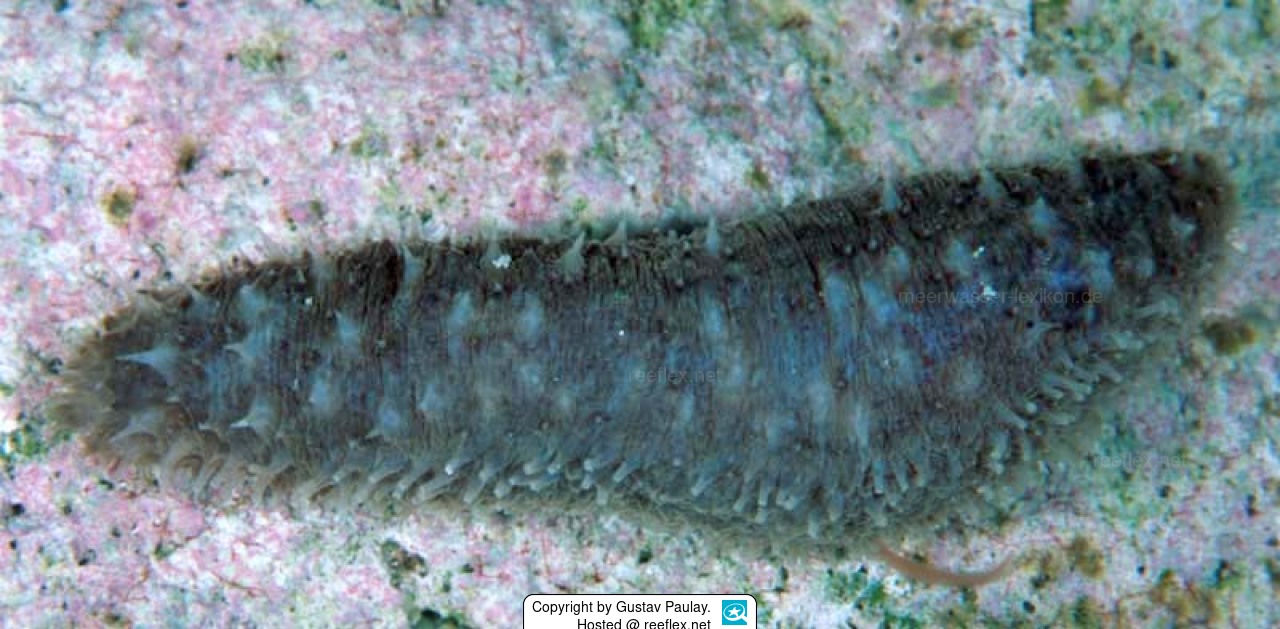Info
Holothuria (Stauropora) discrepans is a very small sea cucumber species, with about 30 tentacles, it occurs on hard substrate and rubble.
It is often found under dead corals or shallow rocks, where it likes to hide to protect itself from predators.
Sea cucumbers of the family Holothuriidae possess, exceptions confirm the rule, so-called Cuvier's tubes (named after the French naturalist Georges Cuvier, * August 23, 1769 † May 13, 1832).
These are long, thin tubes that are located on the rectum of the echinoderms and are flung towards potential predators for defense.
These released tubes form a sticky, tough and stretchy network in which fish, crustaceans or other prey predators can become entangled.
The adhesives may also contain toxins (holothurin).
Sea cucumbers are the vacuum cleaners of the oceans, continuously cleaning the sea floors, so it may be useful for aquarists to keep one or more sea cucumbers in the aquarium to avoid detritus rich zones.
Problem:
Many sea cucumbers of the family Holothuriidae can release their venom into the aquarium water when they are in danger or dying, corals are mostly not harmed by the venom, but fish usually die.
Holothurins can cause severe, burning pain when in contact with the skin and irritation and even blindness when in contact with the eyes. When ingested systemically, the toxins can cause paralysis, muscle spasms, and discomfort in the digestive system, and in larger quantities, death by respiratory paralysis.
Since sea cucumbers are considered a delicacy in many Asian countries, the Cuvier's tubes containing the toxins must be removed before preparation or consumption.
Passively venomous animals do not have a venom apparatus.
Thus, the venom cannot be actively introduced by the animal into another organism.
The venom is not used for prey acquisition. To cause intoxication, it is necessary for the enemy to take the animal into its mouth or eat it. In some cases, toxins can also be absorbed through the skin.
The toxin is either stored in glands (tree climbing frogs) or is accumulated in specific body parts/organs, such as the liver (pufferfish). Again, the venom secretion may be produced by the animal's own secretory cells, as well as by microorganisms, or it may be ingested (at least in part) through food (caterpillars of the scalloped bear).
Passively poisonous animals are referred to as "poisonous" in English.
Source: DocCheck Medical Services GmbH
Synonyms:
Holothuria discrepans Semper, 1868
Stauropora discrepans Semper
We would like to thank Dr. Gusuav Paulay for the first photo of this kind.
It is often found under dead corals or shallow rocks, where it likes to hide to protect itself from predators.
Sea cucumbers of the family Holothuriidae possess, exceptions confirm the rule, so-called Cuvier's tubes (named after the French naturalist Georges Cuvier, * August 23, 1769 † May 13, 1832).
These are long, thin tubes that are located on the rectum of the echinoderms and are flung towards potential predators for defense.
These released tubes form a sticky, tough and stretchy network in which fish, crustaceans or other prey predators can become entangled.
The adhesives may also contain toxins (holothurin).
Sea cucumbers are the vacuum cleaners of the oceans, continuously cleaning the sea floors, so it may be useful for aquarists to keep one or more sea cucumbers in the aquarium to avoid detritus rich zones.
Problem:
Many sea cucumbers of the family Holothuriidae can release their venom into the aquarium water when they are in danger or dying, corals are mostly not harmed by the venom, but fish usually die.
Holothurins can cause severe, burning pain when in contact with the skin and irritation and even blindness when in contact with the eyes. When ingested systemically, the toxins can cause paralysis, muscle spasms, and discomfort in the digestive system, and in larger quantities, death by respiratory paralysis.
Since sea cucumbers are considered a delicacy in many Asian countries, the Cuvier's tubes containing the toxins must be removed before preparation or consumption.
Passively venomous animals do not have a venom apparatus.
Thus, the venom cannot be actively introduced by the animal into another organism.
The venom is not used for prey acquisition. To cause intoxication, it is necessary for the enemy to take the animal into its mouth or eat it. In some cases, toxins can also be absorbed through the skin.
The toxin is either stored in glands (tree climbing frogs) or is accumulated in specific body parts/organs, such as the liver (pufferfish). Again, the venom secretion may be produced by the animal's own secretory cells, as well as by microorganisms, or it may be ingested (at least in part) through food (caterpillars of the scalloped bear).
Passively poisonous animals are referred to as "poisonous" in English.
Source: DocCheck Medical Services GmbH
Synonyms:
Holothuria discrepans Semper, 1868
Stauropora discrepans Semper
We would like to thank Dr. Gusuav Paulay for the first photo of this kind.







 Prof. Dr. Gustav Paulay, USA
Prof. Dr. Gustav Paulay, USA

































